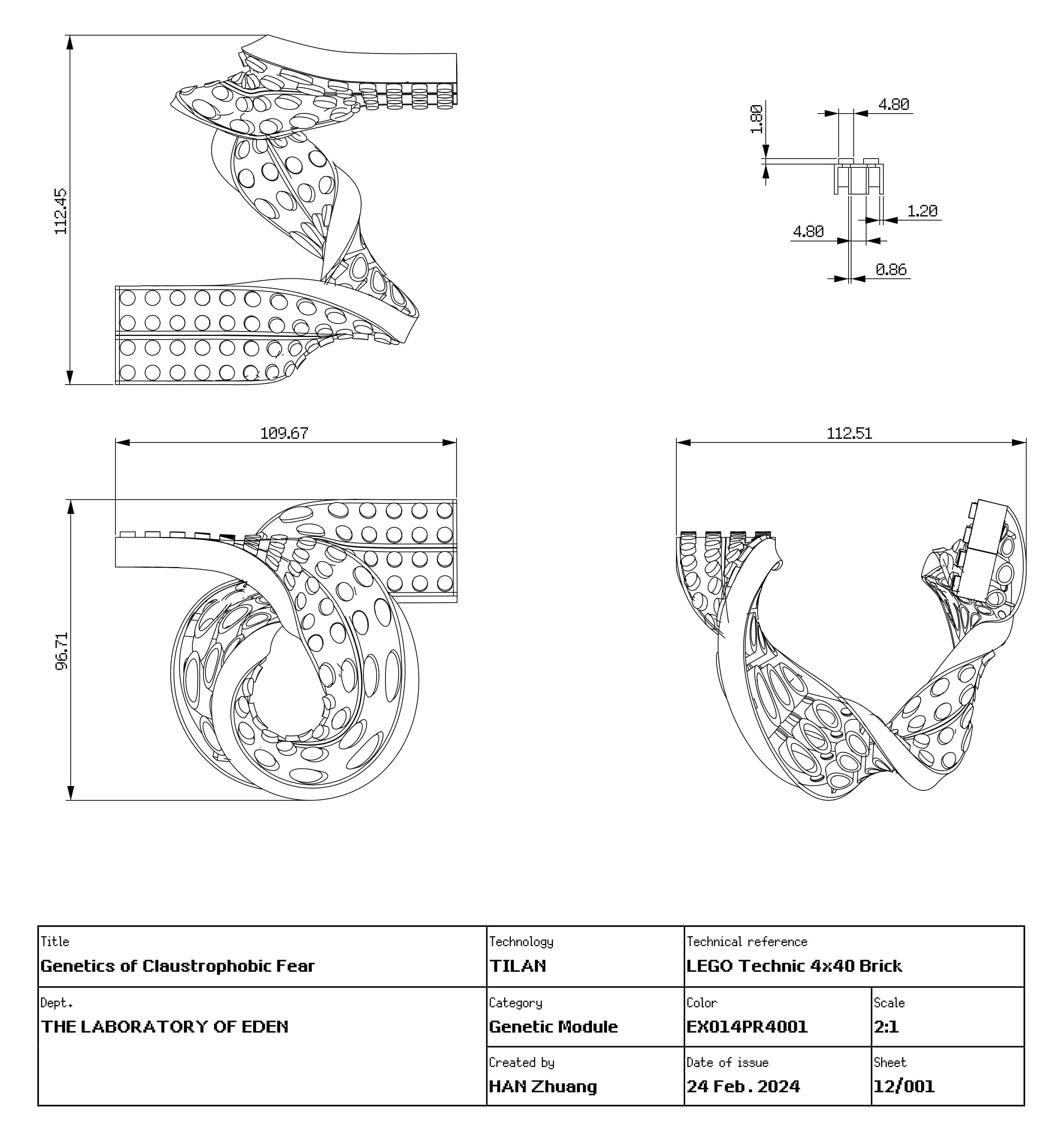Laboratory Background and Analysis
According to Eden Laboratory’s research, claustrophobic fear is the result of a complex interaction between genetic predisposition and environmental experiences. Through the study of genetic markers and behavioral observations, the laboratory has identified that both childhood experiences and genetic background contribute to the manifestation of this fear, which is triggered under specific conditions.
During childhood, in an effort to protect the wolf pack from external predators, your parents placed you in a confined cave. Although this decision was made for safety reasons, the narrow, dark, and escape-limited environment had a lasting impact on your nervous system development. While no immediate behavioral abnormalities were observed at the time, laboratory records suggest that prolonged exposure to such an enclosed space may have influenced the activity of stress-related genes through both genetic inheritance and epigenetic modifications.
As an adult, you were falsely accused by humans of “stealing livestock” and subsequently captured and confined in a narrow metal cage. Although the accusation was unfounded, this event closely resembled your early experiences of confinement, serving as a powerful psychological trigger. The similarity of these circumstances directly activated latent stress-related genetic pathways, leading to severe claustrophobic responses, including acute anxiety, rapid breathing, and escape attempts.

Key Genetic Markers and Functions
| Genetic Marker | Genotype | Functional Description | Behavioral Manifestation |
|---|---|---|---|
| rs110402 | CC | Associiated gene : CRHR1 Gene - Corticotropin-Releasing Hormone Receptor 1 Regulates the hypothalamic-pituitary-adrenal (HPA) axis, a core system for managing stress responses. | Individuals with the CC variant exhibit heightened sensitivity to stress events. This variant is associated with intense anxiety and fear responses, particularly in situations where escape is not possible. |
| rs6198 | GG | Associiated gene : NR3C1 Gene - Glucocorticoid Receptor Gene Reduces cortisol receptor sensitivity, leading to higher cortisol levels and stronger stress responses. | The GG variant increases stress sensitivity, making individuals prone to excessive cortisol release in high-pressure environments, triggering extreme emotional and behavioral reactions. |
Biological Parental Genetic Contribution
| Biological Parents | Genotype and Behavioral Analysis |
|---|---|
| Biological Father | Genotype and Behavioral Analysis : Genetic analysis reveals that your father carries the CC variant of the CRHR1 gene and the GG variant of the NR3C1 gene. Laboratory records indicate that during his youth, your father experienced a landslide while hunting goats, which left him temporarily trapped in a confined cave. This event likely heightened his sensitivity to enclosed environments and was subsequently passed down to you through genetic inheritance. |
| Biological Father | Your mother carries the CT variant of the CRHR1 gene and the GG variant of the NR3C1 gene. Although her genotype suggests a moderate sensitivity to stress, the laboratory hypothesizes that her genetic predispositions have further amplified your heightened sensitivity to confined spaces through hereditary pathways. |
Laboratory Model and Behavioral Manifestations
Genetic Background
- Your claustrophobic tendencies primarily stem from two key genetic variants: CRHR1 (CC) and NR3C1 (GG). These variants were inherited from your parents and are activated under specific environmental stimuli.
Triggering Factors
- Childhood Experiences: Your early life spent in a confined cave established a latent foundation for claustrophobic fear.
- Adult Events: Later experiences of being mistakenly captured and confined in a small metal cage directly activated your stress-related genetic network, leading to pronounced claustrophobic responses.
Epigenetic Regulation
- Early life experiences and adulthood triggers may have influenced gene expression through mechanisms such as DNA methylation or histone modifications.
- While these changes are not permanent, they can alter behavioral patterns for a significant period.
Behavioral Manifestations
- While confined in the cage, you exhibited behaviors such as rapid breathing, marked anxiety, and attempts to break the cage structure.
- These responses align with the typical expression patterns of stress-related genes, indicating that your fear responses are primarily a result of the interplay between genetic predispositions and environmental triggers.
Laboratory Recommendations and Next-Life Parent Matching
| Matching Direction | Recommended Parental Traits | Genetic Optimization Goals |
|---|---|---|
| Next-Life Father Traits | Recommend matching with a father carrying relatively stable alleles of CRHR1 and NR3C1, with adjustments through TILAN technology to moderate sensitivity to stress situations. | Reduce anxiety levels in offspring under high-pressure scenarios and improve tolerance to confined or enclosed spaces. |
| Next-Life Mother Traits | Recommend matching with a mother carrying CRHR1 (CT or lower activity) to reduce phenotypic risk, combined with TILAN optimization to regulate the expression of stress-related genes. In early childhood environments, avoid extreme confinement scenarios. | Minimize epigenetic reinforcement of early environmental stress in offspring, reducing excessive fear or anxiety toward enclosed spaces during development. |
| Genetic Optimization Focus | Apply targeted adjustments to CRHR1 (CC → CT) and NR3C1 (GG → GT) variants, combined with behavioral interventions to limit the expression of high-sensitivity genes in offspring. | Alleviate the incidence of claustrophobia and enhance survival and adaptability in specific environments (e.g., confined caves or enclosures). |
Laboratory Conclusions and Research Directions
Laboratory Conclusions
- Claustrophobic fear is the result of the interaction between genetic factors (CRHR1, NR3C1) and environmental experiences (confined caves, metal enclosures).
- Early experiences can amplify an individual’s fear of enclosed spaces through epigenetic mechanisms, while similar scenarios in adulthood trigger strong expressions of stress-related genes.
Research Directions
- Multi-Gene Interaction Effects: Further investigate other genes associated with claustrophobia (e.g.,loci regulating heart rate and respiratory frequency) and their synergistic effects with CRHR1/NR3C1.
- Reversal of Epigenetic Effects: Explore the impact of nutritional interventions, medications, or behavioral therapies on the regulation of DNA methylation to reduce excessive fear responses to high-pressure environments.
- Personalized Behavioral Training: Develop targeted behavioral training and environmental simulations tailored for claustrophobic traits to help current and future individuals adapt more effectively to confined spaces and sudden enclosure scenarios.